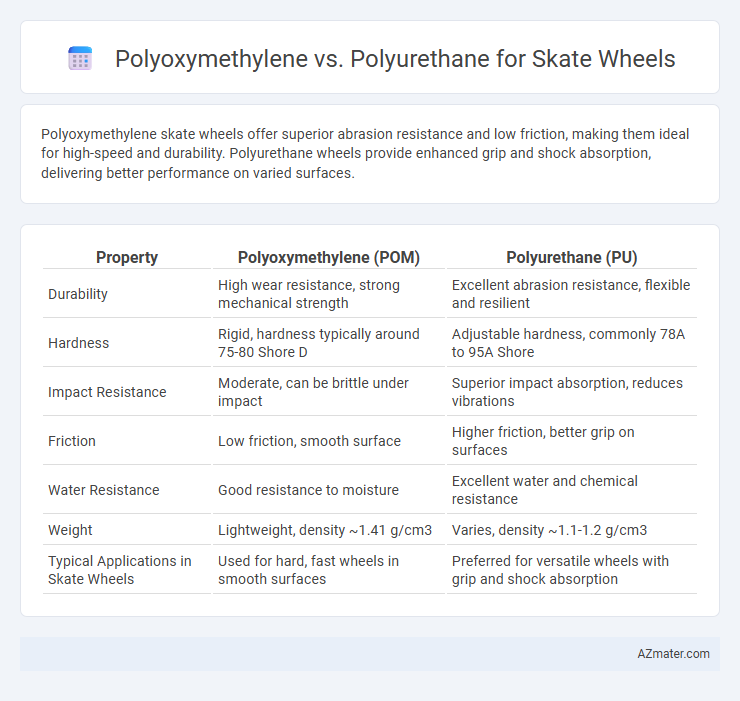Polyoxymethylene skate wheels offer superior abrasion resistance and low friction, making them ideal for high-speed and durability. Polyurethane wheels provide enhanced grip and shock absorption, delivering better performance on varied surfaces.
Table of Comparison
| Property | Polyoxymethylene (POM) | Polyurethane (PU) |
|---|---|---|
| Durability | High wear resistance, strong mechanical strength | Excellent abrasion resistance, flexible and resilient |
| Hardness | Rigid, hardness typically around 75-80 Shore D | Adjustable hardness, commonly 78A to 95A Shore |
| Impact Resistance | Moderate, can be brittle under impact | Superior impact absorption, reduces vibrations |
| Friction | Low friction, smooth surface | Higher friction, better grip on surfaces |
| Water Resistance | Good resistance to moisture | Excellent water and chemical resistance |
| Weight | Lightweight, density ~1.41 g/cm3 | Varies, density ~1.1-1.2 g/cm3 |
| Typical Applications in Skate Wheels | Used for hard, fast wheels in smooth surfaces | Preferred for versatile wheels with grip and shock absorption |
Introduction to Skate Wheel Materials
Polyoxymethylene (POM) offers high stiffness, low friction, and excellent dimensional stability, making it a preferred choice for precision skate wheel cores that require durability and smooth rotation. Polyurethane (PU) is favored for the outer layer of skate wheels due to its superior abrasion resistance, shock absorption, and grip, enhancing overall performance and ride comfort. Combining a POM core with a PU outer layer optimizes wheel efficiency by balancing rigidity and traction for skateboarding or rollerblading applications.
Overview of Polyoxymethylene (POM)
Polyoxymethylene (POM), also known as acetal, is a high-performance engineering thermoplastic widely used in skate wheels for its excellent dimensional stability, high stiffness, and low friction properties. POM offers superior wear resistance and low moisture absorption compared to polyurethane, making it ideal for applications requiring precise tolerances and durability under mechanical stress. Its excellent chemical resistance and ability to maintain strength at varying temperatures contribute to consistent performance in diverse skating conditions.
Overview of Polyurethane (PU)
Polyurethane (PU) is widely favored for skate wheels due to its excellent abrasion resistance, high rebound resilience, and superior grip on various surfaces. Compared to polyoxymethylene (POM), PU offers better shock absorption and durability, contributing to smoother rides and enhanced control. Its versatile hardness range allows customization for different skating styles, making it the preferred material in high-performance skate wheels.
Mechanical Properties Comparison
Polyoxymethylene (POM) offers superior stiffness and dimensional stability compared to polyurethane, making it ideal for skate wheels requiring high rigidity. In contrast, polyurethane provides exceptional abrasion resistance and higher impact toughness, enhancing durability and shock absorption. The mechanical properties of POM include a tensile strength of around 70 MPa and a low coefficient of friction, while polyurethane boasts tensile strength up to 40 MPa but significantly better elasticity and wear resistance.
Durability and Wear Resistance
Polyoxymethylene (POM) offers superior durability and wear resistance for skate wheels due to its high tensile strength and low friction properties, making it ideal for long-lasting performance on rough surfaces. Polyurethane (PU), widely favored in the skating industry, provides excellent abrasion resistance and shock absorption, ensuring smoother rides and less wear over time. While POM excels in mechanical strength and rigidity, polyurethane's elastomeric nature delivers better impact resilience, crucial for aggressive skating conditions.
Grip and Traction Performance
Polyurethane skate wheels offer superior grip and traction due to their high elasticity and ability to conform to various surfaces, enhancing control during turns and stops. Polyoxymethylene wheels, while more rigid and durable, tend to provide less grip, resulting in reduced traction and a slide-prone experience on smooth or wet terrain. For skaters prioritizing grip and traction, polyurethane remains the optimal material choice in performance skate wheels.
Shock Absorption Capabilities
Polyurethane skate wheels offer superior shock absorption capabilities compared to polyoxymethylene (POM) wheels, providing smoother rides on rough surfaces by effectively dissipating impact forces. Polyoxymethylene, known for its rigidity and high wear resistance, lacks the elasticity needed to absorb shocks, resulting in a stiffer ride and increased stress on the rider's joints. Choosing polyurethane wheels enhances comfort and reduces vibration, making them ideal for aggressive skating and uneven terrains.
Weight and Impact on Skating
Polyoxymethylene (POM) skate wheels are lighter than polyurethane wheels, reducing overall board weight and enhancing maneuverability during tricks. Polyurethane wheels offer superior shock absorption and durability, providing a smoother ride on rough surfaces while better resisting wear. Lightweight polyoxymethylene wheels favor speed and agility, whereas polyurethane wheels prioritize comfort and long-term impact resistance for various skating styles.
Cost and Availability Analysis
Polyoxymethylene (POM) skate wheels generally offer a cost-effective option with moderate durability, making them suitable for budget-conscious skaters and mass production due to wide availability in plastic manufacturing. Polyurethane (PU) skate wheels, while typically more expensive, provide superior performance characteristics such as increased grip, resilience, and shock absorption, making them the preferred choice for professional and high-performance skating applications. Availability of PU wheels varies by quality grade and manufacturer, often reflected in higher pricing compared to commonly stocked POM wheels.
Choosing the Best Material for Your Skate Wheels
Polyoxymethylene (POM) offers high stiffness, low friction, and excellent dimensional stability, making it ideal for smooth and durable skate wheels that maintain shape under stress. Polyurethane (PU) provides superior grip, shock absorption, and wear resistance, enhancing control and comfort on varied surfaces for versatile skating performance. Selecting between POM and PU depends on riding style: POM wheels suit speed and precision, while PU wheels excel in traction and resilience for diverse terrains.

Infographic: Polyoxymethylene vs Polyurethane for Skate Wheel
 azmater.com
azmater.com